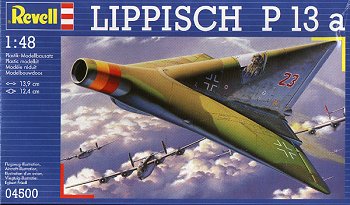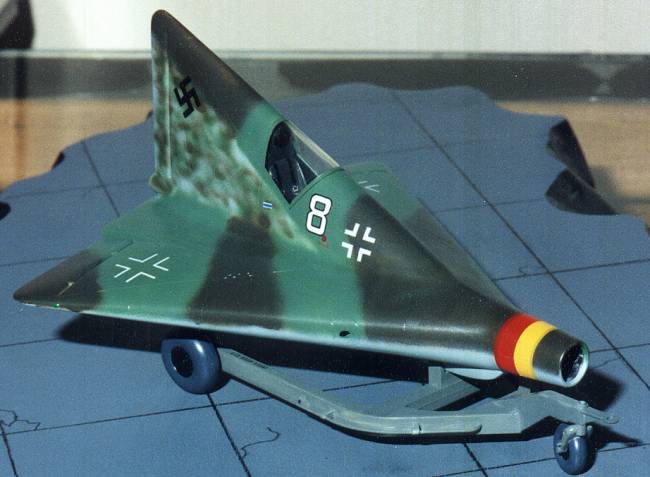
Kit: Lippisch P13a

Scale: 1/48
Kit Number: 4500
Manufacturer: Revell
Price: $12.00
Media: Injected Plastic
Decals: Two versions; JG 300 and JG 301
Date of Review: 17 December 1997
Reviewer: Scott Van Aken

This is one of the first 'Luftwaffe 1946' kits that was mass injection molded. It was originally produced by Mauve and had a number of etched metal parts included. It was also about $40.00. Frankly, I don't see how many were sold as there are not that many parts in this kit. It is supposed to be a ram-jet powered fighter. Now ram-jets won't work unless the aircraft is already at high speed, so a rocket engine was included in this to get the needed speed to start the ram-jet. The type was to have no landing gear; just a skid, very much like an Me-163.
Dr. Lippisch was a pioneer in the development of delta winged aircraft and his work eventually led to the XF-92, F-102, F-106 and B-58 in the US and the Mirage III, IV, and V in France. The P.13a was on of his initial designs, so you could say this is the granddaddy of all those other aircraft. If you haven't figured it out already, this plane never left the drawing board, although there was a glider, the DM-1 that was highly successful. Huma makes a 1/72 kit of that aircraft if you are interested.
I have not said much about the kit as there are only 20 parts to it. Six of them make up the ground handling trolley. The average 10-year old could have this kit together and playing within about three hours. Naturally, I took a bit longer! There is an exhaust that fits in the aft section that is trapped by the wings. There is no blanking plate at the front to prevent see-through so I installed one. Actually, you probably could see through a ram-jet, but it just didn't look right. That is the main fuselage/wing assembly; three parts.
The tail halves are next. The interior fits on the top of the wing and consists of rudder pedals, seat, stick, instrument panel and a back plate. There is also a star-shaped control wheel that fits on the cockpit wall. That's it. The tail section/cockpit fits over the interior parts and onto the top of the wing. A very clear canopy then fits into place...Kit assembled.
This one was done in late war colors of brown-violet (RLM 81) and light green (RLM82) over light blue (RLM 76). Part of the sides of the tail were done in 76 and that area mottled with 81 and 82. The Revell decals are very flat and relatively poor. Toss them. I used only the 'fuselage' Reich Defense band for JG 301. The rest of the decals came from the spares box as did the swastika since Revell did not supply one.
The end result is a very small, easy to build and interesting 'what if' kit.
